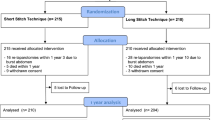Abstract
Background
The reconstruction of wide, full-thickness abdominal wall defects of the midline presents a continuing challenge, and consensus concerning the appropriate surgical treatment is lacking.
Method
In this retrospective review, we describe a simple method of reconstruction in full-thickness defects initially treated with skin grafting directly on to the surface of the intestines. Instead of removing the split-thickness grafts from the surface of the intestines, the abdominal wall was reconstructed by inverting the grafted area and advancing the rectus muscles towards the midline.
Results
Four patients with full-thickness transverse defects larger than 10 cm at the level of the waist and extending from the xiphoid to the suprapubic region were operated with this method. All healed uneventfully. In one case, microscopic examination of the inverted skin showed transformation to normal connective tissue.
Conclusion
Reconstruction of abdominal wall defects previously treated with skin grafting directly on to the intestines can be safely done by reposition of the skin-grafted intestines into the abdominal cavity and realignment of the rectus muscles in the midline.




Similar content being viewed by others
References
Korenkov M, Sauerland S, Arndt M, Bograd L, Neugebauer EA, Troidl H (2002) Randomized clinical trial of suture repair, polypropylene mesh or autodermal hernioplasty for incisional hernia. Br J Surg 89:50–56
Kama NA, Coskun T, Yavuz H, Doganay M, Reis E, Akat AZ (1999) Autologous skin graft, human dura mater and polypropylene mesh for the repair of ventral abdominal wall hernias: an experimental study. Eur J Surg 165:1080–1085
Lucas CE, Ledgerwood AM (1998) Autologous closure of giant abdominal wall defects. Am Surg 64:607–610
Depuydt K, Boecks W, D’Hoore A (1998) The pedicled tensor fasciae latae flap as a salvage procedure for an infected abdominal mesh. Plast Reconstr Surg 102:187–190
Ninkovic M, Kronberger P, Harpf C, Rumer A, Anderl H (1998) Free innervated latissimus dorsi muscle flap for reconstruction of full-thickness abdominal wall defects. Plast Reconstr Surg 101:971–978
Ramirez OM, Ruas E, Dellon AL (1990) “Components separation” method for closure of abdominal-wall defects: an anatomical and clinical study. Plast Reconstr Surg 86:519–526
Shestak KC, Edington HJD, Johnson RR (2000) The separation of anatomic components technique for the reconstruction of massive midline abdominal wall defects: anatomy, surgical technique, applications, and limitations revisited. Plast Reconstr Surg 105:731–738
Ekeh AP, McCarthy MC, Woods RJ, Walusimbi M, Saxe JM, Patterson L (2006) Delayed closure of ventral abdominal hernias after severe trauma. Am J Surg 191:391–395
ASA physical status classification system (2006) American Society of Anesthesiologists. http://www.asahq.org/clinacalinfo.htm
Author information
Authors and Affiliations
Corresponding author
Rights and permissions
About this article
Cite this article
Stark, B., Strigård, K. Definitive reconstruction of full-thickness abdominal wall defects initially treated with skin grafting of exposed intestines. Hernia 11, 533–536 (2007). https://doi.org/10.1007/s10029-007-0235-2
Received:
Accepted:
Published:
Issue Date:
DOI: https://doi.org/10.1007/s10029-007-0235-2




